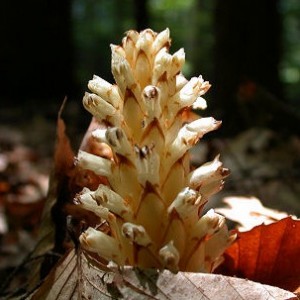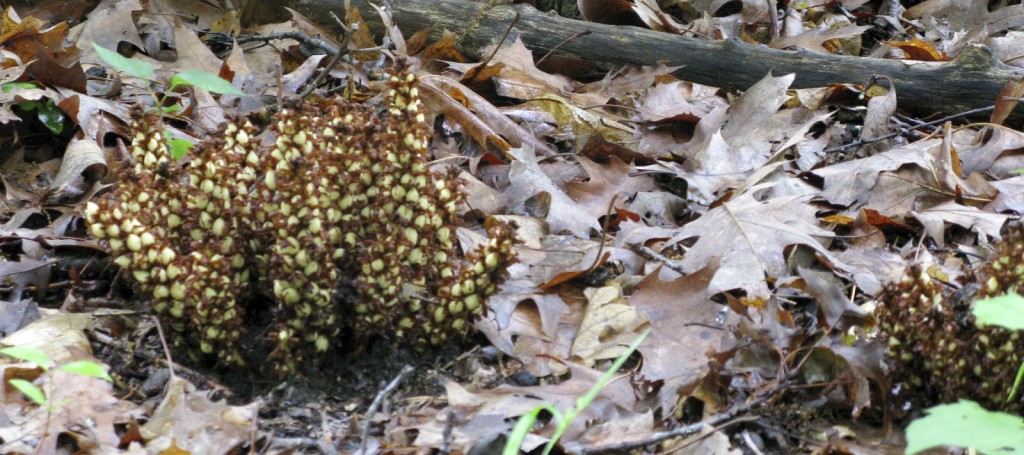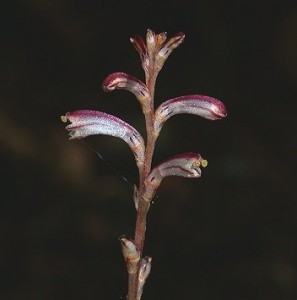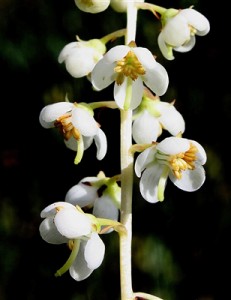Thieves in the Forest
Posted in Around the Garden, Learning Experiences on June 20 2012, by Matt Newman

Strange things are afoot under the eaves of the trees. Or is it more appropriate to say that they’re underfoot, period? Either way, take a walk by the NYBG‘s Forest and just maybe you’ll see a few shady swindlers lurking in the underbrush.
Like the family cat or man’s best friend, trees tend to pick up their share of freeloaders as they go through life, though in this case we’re not talking about fleas or dreaded tapeworms. It’s a topic I tackled in part when we discussed the skullish blooms of the corpse plant only a few months ago. And like that pale parasite, there are other native bloodsuckers found in the forests of New York that are just as fond of mooching on their friends.
Take Conopholis americana. Walking through the woods in spring, you might stumble over a strange growth poking its clunky “tentacles” out from around the roots of an oak tree. The thick, almost spiked stalks of the plant have no leaves, but instead grow brown scales beneath yellow-white flowers. You’re looking at squawroot. Also known as “bear corn” for its status as a delicacy among black bears, this homely little growth no longer uses chlorophyll to convert sunlight, like most plants, but skips the photosynthesis for a habit of vegetative vampirism. This makes it what is known as a holoparasite.

Once it’s settled in under its chosen oak, squawroot sucks nutrients straight from the tree, causing ugly, rounded knobs to grow on the subterranean roots where it attaches. But it’s not all bad with this oddball growth–its overall effect on the health of the host tree is relatively minor. It may even be beneficial for humans. Native Americans being the first to discover its properties, they named squawroot for its use in treating the symptoms of menopause, not to mention headaches and its function as a mild astringent.

Less useful to us is another native New Yorker sometimes referred to as “cancer root,” known more innocuously as beechdrops (Epifagus americana). Feeding exclusively on beech trees, it shares many of the traits and habits of squawroot, though its spindly stems and purple-red fall flowers set it apart.
In centuries past, physicians would use beech drops to create poultices, herbaceous salves spread on bandages that they would then wrap over a patient’s cancerous lesions. I should probably mention that the other half of the recipe was white arsenic, a well-known poison in the West. The concept isn’t entirely insane if you look at the controlled use of arsenic compounds in modern medicine, but the beechdrops’ probably didn’t add much to the concoction. So think twice before you make the mistake of slapping this gruel on your open wound; I’m not sure the average health insurance provider has a contingency for that kind of behavior.

Rounding out the police lineup, we find a two-faced Garden plant with something of an identity disorder. American wintergreen (Pyrola americana) is seen most often in its autotrophic variety, a sun-loving plant with amiable green leaves and shy flowers blooming in pinks or creams; the Cherokee would sometimes place the leaves on cuts to aid healing. But on the other side of the coin is a darker variety of wintergreen, chlorophyll-free and boasting red leaves, if any at all. And as a myco-heterotroph, it can only grow when parasitically attached to another organism, much like bear corn and cancer root; in this case, “myco” refers to its sweet tooth for feeding on underground fungi, the same mycorrhizal fungus that forms a symbiotic relationship with trees, and supports the growth of the giant pumpkins that we showcased last Halloween.
What fascinates botanists about this breed is that each aspect of the plant really is a separate side of the same coin. Pyrola is one of only a few plant groups to produce species in both autotrophic and parasitic varieties, something that pushes the evolutionary envelope as we currently know it.
Native parasites, like any vegetation, are an inherent part of the ecosystem to be found in almost every New York forest. So when you come to the NYBG, take some time out from Monet’s Garden to walk the trails of the Forest; you might catch sight of a parasite or two, to be appreciated for their weird beauty, if not their strange habits.
“Native species growing in conjunction with other native species is a beautiful thing,” adds Plant Records Manager Jon Peter. “Pyrola, beechdrops, and squawroot are usually a surprise you stumble upon in the forest, an unknown for most and quite exciting to see and learn about.”
Really, it’s best to find a little acceptance for even the most conniving of local plantlife.
Squawroot and Cancer root photos courtesy of Botany Blog.
American wintergreen photo courtesy of The University of Michigan Herbarium.

